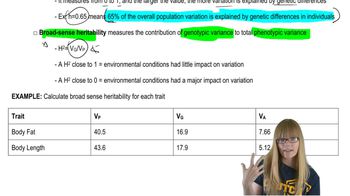Polygenic traits are usually continuous traits?
Table of contents
- 1. Introduction to Genetics51m
- 2. Mendel's Laws of Inheritance3h 37m
- 3. Extensions to Mendelian Inheritance2h 41m
- 4. Genetic Mapping and Linkage2h 28m
- 5. Genetics of Bacteria and Viruses1h 21m
- 6. Chromosomal Variation1h 48m
- 7. DNA and Chromosome Structure56m
- 8. DNA Replication1h 10m
- 9. Mitosis and Meiosis1h 34m
- 10. Transcription1h 0m
- 11. Translation58m
- 12. Gene Regulation in Prokaryotes1h 19m
- 13. Gene Regulation in Eukaryotes44m
- 14. Genetic Control of Development44m
- 15. Genomes and Genomics1h 50m
- 16. Transposable Elements47m
- 17. Mutation, Repair, and Recombination1h 6m
- 18. Molecular Genetic Tools19m
- 19. Cancer Genetics29m
- 20. Quantitative Genetics1h 26m
- 21. Population Genetics50m
- 22. Evolutionary Genetics29m
3. Extensions to Mendelian Inheritance
Overview of interacting Genes
Problem 3
Textbook Question
Compare and contrast broad sense heritability and narrow sense heritability, giving an example of each measurement and identifying how the measurement is used.
 Verified step by step guidance
Verified step by step guidance1
Broad sense heritability (H²) measures the proportion of phenotypic variance in a population that is attributable to all genetic variance, including additive, dominance, and epistatic effects. Narrow sense heritability (h²), on the other hand, measures the proportion of phenotypic variance that is due specifically to additive genetic variance, which is the component passed from parents to offspring.
To calculate broad sense heritability (H²), use the formula: , where is the total genetic variance and is the total phenotypic variance.
To calculate narrow sense heritability (h²), use the formula: , where is the additive genetic variance and is the total phenotypic variance.
An example of broad sense heritability is studying the genetic contribution to height in a population, where dominance and epistatic effects are included. This measurement is used to understand the overall genetic influence on a trait.
An example of narrow sense heritability is estimating the heritability of milk production in dairy cattle, focusing on additive genetic variance. This measurement is used in selective breeding programs to predict the response to selection.
 Verified video answer for a similar problem:
Verified video answer for a similar problem:This video solution was recommended by our tutors as helpful for the problem above
Video duration:
3mPlay a video:
Was this helpful?
Key Concepts
Here are the essential concepts you must grasp in order to answer the question correctly.
Broad Sense Heritability
Broad sense heritability (H²) measures the proportion of phenotypic variance in a trait that can be attributed to genetic variance, including additive, dominance, and interaction effects among alleles. It provides a comprehensive view of genetic influence on traits, but does not distinguish between different types of genetic contributions. For example, in a study of plant height, broad sense heritability would consider all genetic factors affecting height, making it useful for understanding overall genetic potential.
Recommended video:
Guided course

Calculating Heritability
Narrow Sense Heritability
Narrow sense heritability (h²) focuses specifically on the proportion of phenotypic variance that is due to additive genetic variance alone. This measurement is crucial for predicting the response to selection in breeding programs, as it reflects the heritable traits that can be passed on to the next generation. For instance, in livestock breeding, narrow sense heritability would be used to estimate how much of the variation in milk production is due to additive genetic factors, guiding selection decisions.
Recommended video:
Guided course

Calculating Heritability
Applications in Genetics
Both broad and narrow sense heritability are essential in genetics for understanding trait inheritance and guiding breeding strategies. Broad sense heritability helps researchers assess the overall genetic contribution to traits, while narrow sense heritability is more applicable in predicting the outcomes of selective breeding. For example, in agriculture, knowing the narrow sense heritability of crop yield can inform farmers on which plants to select for future planting to enhance yield.
Recommended video:
Guided course

Descriptive Genetics

 7:56m
7:56mWatch next
Master Interacting Genes Overview with a bite sized video explanation from Kylia
Start learningRelated Videos
Related Practice
Multiple Choice
616
views
4
rank
